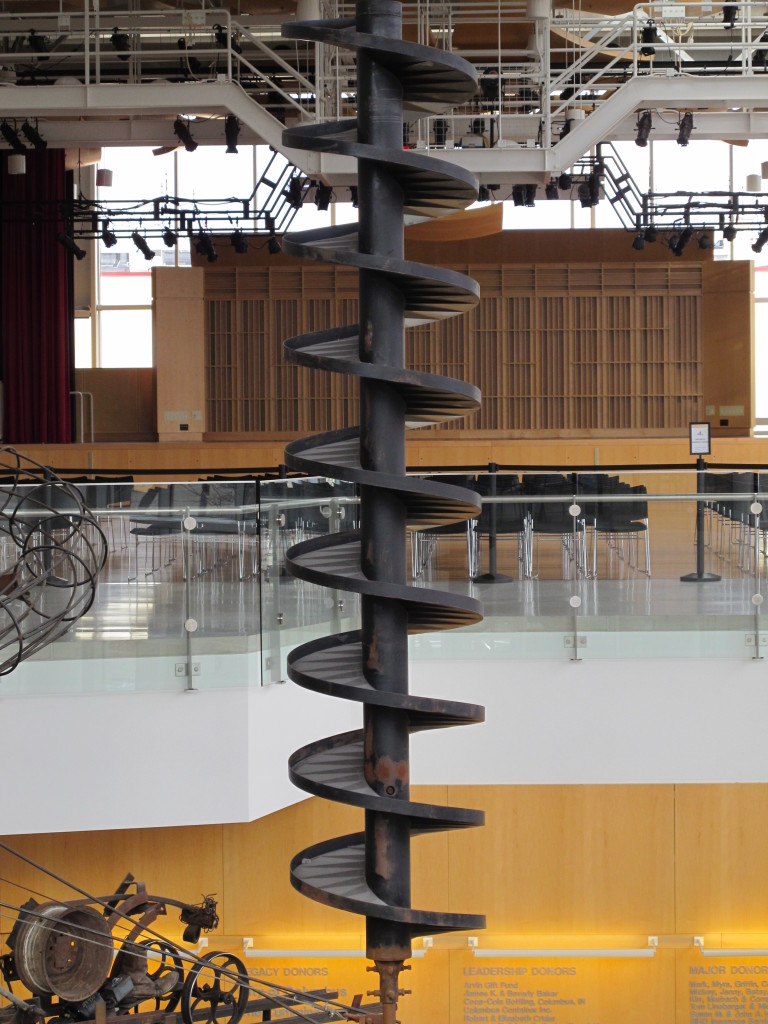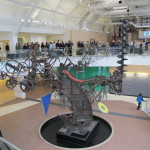 Chaos I
Chaos I
- Built: 1974
- Restoration: 2010
- Location: Inside The Commons – 300 Washington Street
- Artist: Jean Tinguely
“Chaos I” is a large kinetic sculpture by Swiss artist Jean Tinguely located inside The Commons in downtown Columbus. The work was commissioned by J. Irwin Miller, his wife Xenia and his sister Clementine Tangeman to be a focal point in the public space called The Commons which was adjacent to the indoor shopping mall that was originally called the Courthouse Mall all designed by Cesar Pelli. It was part of a major downtown redevelopment program starting in the late 60’s. The shopping mall and the public space opened in the early 70’s and the sculpture was installed in 1974. Most of the shopping mall itself has now been demolished and replaced by office buildings and the community space where Chaos stands has been completely rebuilt with the sculpture staying in the same place throughout the transformation period.
Pelli had envisioned a large sculpture to act as a focal point of the Commons, a place for people to meet and greet. He created the vast community space next to the shopping mall as a modern indoor version of an Italian piazza. He thought the space needed a giant “toy”, a whimsical clock-like structure that would be intriguing to both children and adults. He envisioned it as a meeting and gathering place for people coming downtown. He convinced J. Irwin Miller to commission a work by Swiss sculptor Jean Tinguely who was well known for creating large scale kinetic sculptures around the world. Pelli was especially impressed by a Tinguely work in Zurich, Switzerland called “Eureka” that bears certain similarities to our Chaos. The Miller’s and Clementine Tangeman reportedly paid $130,000 for the sculpture as a gift to the city
What resulted was “Chaos I”, a 30 foot tall, 30 foot at its widest point, 7 ton structure that was fabricated mostly of scrap material found in and around the local area. The sculpture moved, changed and made noise in a seemingly random manner throughout the day. Initially it had what has been defined as 13 different functions that moved over 50 individual components with 12 different motors, including a function that once pivoted the entire sculpture 70 degrees at the base. Over time several of the movements were disabled particularly the pivoting of the base which was deemed unsafe both to the sculpture itself and the public walking by. Tinguely himself wanted it to appear rickety as if something might fall off at any given moment. Tinguely considered it to be one of his best works and described it as: “Life is movement. Everything transforms itself, everything modifies itself ceaselessly and to try to stop it seems to me a mockery of the intensity of life.” Pelli saw it as a modern version of the clock in a traditional town square. Although residents were skeptical at first, it gradually became a beloved icon to most of Columbus. A shallow water-filled moat surrounds the sculpture pedestal which of course became a wishing well with adults and children alike tossing coins in around the base of Chaos. Sometimes a childs first instinct is to jump into the very shallow pool and try to recover a coin or two but it only takes a quick adult lesson to convince them of the joys of wishing. The name of the sculpture came from the fact that Tinguely saw the adjacent playground as “Chaos #2.” Tinguely apparently didn’t put a lot of effort into choosing the name but he did always refer to his machine as a “she”. When asked about the name, Tinguely just shrugged and said, “the name will do.”
Pelli wanted to the sculpture to operate in a consistent manner like a clock while Tinguely insisted that it be completely random in its movements. What resulted in its original configuration was having the sculpture cycle through a series of motions that simulates a day in a life, beginning slowly at first, adding movements as it builds to a noisy, even angry crescendo and then winding down again at the end of the day. It was described as having a “Jekyll and Hyde” personality so visitors could experience it sometimes as being calm and peaceful with only a few functions working and other times with all of them working at once becoming a noisy, angry, clanging and yes chaotic machine. As originally programmed in 1974, it was meant to have all elements running around 12:00pm and 6:00pm with lesser operation of various elements throughout the rest of the day. This was also the default programming of the restored Chaos along with the ability to set up different daily scenarios as desired or to shut it off completely by remote control if an event is taking place in the space.
Tinguely’s original intention was to produce the sculpture in Paris and have it shipped to Columbus but after several visits he decided to do all the work here. It seems he had developed a genuine affection for the people and the local culture in Columbus. He was known to enjoy consuming American meals of steaks and french fries at local restaurants and spent many of his evenings in local bars, particularly the Columbus Bar on 4th Street across the street from the Commons. He enjoyed walking the downtown streets and was sometimes seen driving around the area in a tan Ford pickup. He spent nearly two years off and on in Columbus working on the project. Tinguely was an unusually colorful character by normal Columbus standards with his walrus mustache, busy eyebrows and was often seen wearing a colorful neck scarf. While in Columbus Tinguely’s affairs were handled by the Irwin Management Co. and he and his assistants stayed in a house they provided him on Youth Camp Road.
Chaos was fabricated from new and scrap material much of it purchased in or from the Columbus area. He spent a considerable amount of time in Columbus gathering materials and constructing Chaos. Tinguely was reportedly quite impressed with the high quality of our scrap metal supply! The scrap metal came from the then downtown Kroot Corp. scrapyard as well as the former downtown city dump. A large bearing used on the base came from the Southern Machine Co. and many of the spinning metal shapes were created by Noblitt Fabricating. The original 12 motors, gear reducers and electrical supplies were supplied by the Daniel-Hayden Electric Co. Verl Mauzy, an electrical engineer with Daniel-Hayden Electric Co. designed and built the control panel that enabled the sculpture to be programmed or to be turned off entirely. 7 of the 12 motors were manufactured locally by the Reliance Co. The project was constructed at the old Columbus Pump House/Senior Center building which had been recently vacated by the Southern Machine Co. Tinguely and his assistant Josef “Sappi” Imhof worked with local craftspeople to gather materials and construct the project and then moved it in pieces to the final site in the Commons. Tinguely was 47 at the time Chaos was constructed and he had created at least 400 prior kinetic sculptures. At that point in time, Chaos was his largest work and he considered it to be his very best.
The entire sculpture is mounted on a substantial steel base resting on a concrete pedestal with a 1/2′ thick layer of cork between them to minimize vibration into the rest of the building. Four very large nuts and bolts anchor the lower platform of the sculpture onto the base. It is surrounded by a moat with a shallow pool of water. A large flat piece of curved steel is the primary vertical element onto which all the other various pieces attach to. Some have criticized the new Commons space as being too confining for the giant sculpture but the upper parts of Chaos can now be closely viewed on three sides by the new mezzanine surrounding it on the upper level.
The final sculpture had 12 motors that could be programmed for various sequences of 13 functions. They were all standard industrial motors with special gearing arrangements to get the speeds that Tinguely desired. Wheels spin, a rotating auger swirls, a wagon on a track rolls out and back, shapes revolve, cannonballs roll etc. Each of the 12 functions had a dedicated motor except for the “Clangers” which were activated by the Wheels Pivot function. It is interesting to note that Tinguely left no detailed plans or descriptions behind and certainly not a maintenance manual. He worked from a few hand drawn sketches but it was mostly constructed on the fly as he went along. There were immediate concerns in the community that this unique structure might not be safe and that there were no real guidelines of how to take care of it. William R. Thompson (Thompson Associates) was contracted to do an engineering analysis and a safety review. Noting the complexity and uniqueness of Chaos, Thompson declared that a full blown analysis of every possible combination of factors would take a total of 5461 years for separate influence analysis using hand calculations! Therefore Thompson proceeded with what he described as a practical review by intuition and engineering judgement combined with elementary statical checks of the most critical areas of concern. Thompson came up with a description of individual functions mostly centered around the individual motors driving each of those functions. He ran each function separately and in various combinations to determine their effect on other parts of the structure. His report also laid out a suggested course of action for periodic safety checks and maintenance. The following is a description of all 13 functions in the Thompson report and what I know about their present state. For the sake of consistency and documentation of maintenance, these naming conventions and descriptions have been maintained and used as well in the 2010 restoration.
#1. Wheels – a series of slow running, metal-clad, split-wood pulley wheels of different sizes connected by several pulley systems and drive belts (some appear to be Reeves split-wood pulley wheels but they are are believed to have been manufactured by Lewellen Manufacturing in Columbus). The wheels were originally intended to be able to run in the reverse direction as well but the Thompson engineering report recommended that it be modified to run in only one direction to keep the belts from slipping off as well as a potential misalignment/damage to the “clangers” function.
#2. Wheels Pivot – As the wheels are turning there is an approximately 30 degree pivotal up and down swing of the “wheels section” about a shaft in the vicinity of the wheels. The entire assembly lowers and then returns to the original position.
#3. Clangers – a clanging sound is generated by the periodic drop of 2 tubular hammers against an tubular steel anvil when the “Wheels Pivot” function reaches its down position (the rotating clanger arms would only function when the “Wheels Pivot” function is in operation). It was thought that the ends of the clangers were cut off sometime in the 90’s to reduce noise but the failure to operate appeared to actually be a misalignment of the elements. This is the only documented function not requiring its own motor.
#4. Balls – hollow steel “cannonballs” are raised to the top by a hay-lift elevator (modified from farming equipment) and then released onto a wire cage track allowing them to roll back to the bottom of the lift mechanism. There were originally 5 balls weighing between 6-8 lbs each and were fabricated from multiple pieces of steel welded together. As part of the restoration, the balls were inspected and some damage repaired with additional material added to bring them all to a weight of at least 7 lbs. It was decided to only keep 4 of the most reliable balls on the structure. This has been the function causing the most problems over the years even after the latest restoration. It has always been the most popular part of Chaos by the general public and many are disappointed that it seldom is operating.
#5. Yellow Doughnut – a 36″ hollow revolving doughnut shape, yellow on one side and orange on the other. During the restoration the element was cleaned and then repainted by local artist Jeri Cannon.
#6. Dull Triangle – a revolving triangular shape, dull blue on one side and unpolished aluminum on the other. As part of the restoration it was decided that it was hanging too low and posed a safety hazard to passersby. The revolving arm holding the element was shortened raising the height of the triangle by 4 inches. This element was also repainted by Jeri Canon.
#7. Stainless Diamond – a revolving stainless steel diamond shape, polished on one side and flat black on the other. During the restoration this element was removed and had to be re-fabricated due to structural problems.
#8. Small Disc – consists of a 24″ white aluminum disc that traces a path 10′ in diameter with a fin-like element attached to the other end as counterbalance. This element was repainted by Jeri Canon.
#9. Miscellaneous Twisters – various small items (a small doughnut, a triangle and an abstract boot-like shape) that twist by means of connected shafts and belts. The small doughnut is made of hollow steel and is white on one side and dark green on the other. The small steel triangle is made of steel, painted black on one side and yellow on the other. The abstract form is blue on one side and reddish black (with white under) on the other.
#10. Cart – a rolling multi-wheeled wagon on a track that goes out and comes back in, pulled along the track by a locomotive-style connecting rod with a 5 foot orange/red arm. There are 8 plastic wheels that allow it to roll smoothly along the track as well as 2 large decorative wheels in the front meant to be wobbly and rattling. Total transverse of the cart is 10 feet out and back. It features a very prominent BOOT! During the restoration, certain parts of the cart were repainted by Jeri Canon and the boot was cleaned to help preserve it.
The BOOT that sits on the rolling cart device has always been one of the most popular and pointed out items on the sculpture. There have been a number of different stories on how and why it got there. To the best of my knowledge this is the mostly correct version. The boot belonged to Robbins Electric foreman Rudy Knies. Whether it was a prank (some said he took off his boots during a lunchtime siesta and had one of them snatched away) or by his own intention, it wound up being temporarily placed on top of the tall spiraling auger and Tinguely left it there throughout the construction phase and then had it removed. After experiencing a series of mechanical problems, Tinguely came to believe that removing it had “jinxed” the sculpture and he had it put back on Chaos but this time onto the rolling cart where it has stayed. People who had been watching the progress of the construction had also noticed it missing and were asking what had happened to it.
#11. Cart Arm – an operation within the cart that has a plunger-like action when the cart is rolling with miscellaneous items attached to the end meant to resemble a head (bolts for eyes, wire and twine for hair, and a rubber nose). This has sometimes been called the “snipper” as it appears to be snippng the air as the cart rolls outward.
#12. Auger – a tall slender black steel auger that swirls with a counterclockwise, vertical twisting motion.
#13. Base Twist – the entire sculpture can rotate 70 degrees about a pin on the base. This function was eliminated in 1985 as it was felt that it was a danger to both the machine itself as well as those standing near it. It was considered as part of the restoration process to use this function only during carefully controlled exhibitions but apparently it will never be used again.
The Commons itself was not yet open in February of 1974 as Chaos was being installed. Residents and visitors were able to view the final installation from the already open Courthouse Mall shopping center and the partially open Commons mezzanine. Reactions varied from fascination, bewilderment, laughter and sometimes outright anger. Tinguely took great delight in hearing and seeing their reactions as opposed to the more studied and serious observations one might encounter in a gallery or museum. Many questioned whether it was actually a work of art and Tinguely would be quick to agree with them. He felt that even those who disliked Chaos would stand watching and be drawn deeper into the work. He did disagree with several “improvements” suggested by the results of the engineering analysis but usually was willing to compromise to get the work accepted.
Quote from Jean Tinguely on CHAOS, 1972:
“This machine should be able to have two faces. One way coexisting with the situation of the city mall and the other fighting against all and making noises, being fast, being very confusing and then…back to the quiet life of a good sculpture…A sculpture like Dr. Jekyll and Mr. Hyde.”
Tinguely’s assistants Josef Imhof and Paul Wiedmer stayed behind in Columbus to watch over the sculpture and to work out issues as they came up. Tinguely came back to Columbus a number of times to work out improvements, agree to changes and otherwise ensure that Chaos was operating properly. At one point Paul Wiedmer hid inside a large packing crate to watch the people watching the sculpture and gauge their reactions. He was filming from inside the box and other locations with a home movie camera but apparently none of the film was usable. It took at least a year after the final installation to work out all the bugs and to keep Chaos running reliably.
The sculpture has operated fairly reliably over the years but at some points different parts of Chaos and occasionally the entire thing had to be shut down temporarily to make repairs. A fairly consistent maintenance schedule has been maintained over the years to keep it functioning. The “old” Commons closed on New Years Eve 2007 and Chaos itself was left in place as the building was demolished around it. The Commons community space was rebuilt (minus the shopping mall) using the original steel superstructure from the Pelli building, but the sculpture remained in place during the demolition and rebuilding process protected in a large green climate-controlled enclosure. The loving protection was ironic to many since so much of it was scrap metal from the junkyard in the first place.
As the “old” Commons was torn away and the “new” Commons was nearing completion, Chaos was unwrapped and restoration efforts began in 2010. The intention was to return as many functions as possible to working order while presenting the sculpture in a state that while it may show its age it nonetheless shows that it was an important and well-cared for work of art. It was refurbished: cleaned, repaired and certain parts repainted without attempting to make it look new and brought up to more modern electrical control standards. Irwin Management donated $100,000 toward the restoration efforts with most work performed by Taylor Brothers Construction and their president David Doup overseeing the project. Art Conservator Richard McCoy was a consultant on the project researching the function of each piece of the sculpture. Tinguely left few detailed plans behind. McCoy and the restoration team relied upon a structural engineering report completed by William Thompson of Thompson and Associates in 1974, old newspaper articles, a stenciled numbering system on the sculpture itself and a 16mm film that had been all but forgotten. In 1974, the Commons Board of Directors had commissioned Minnesota filmmaker John Denney to produce a documentary film of Tinguely and Chaos during the design and assembly stage. The Indiana Arts Commission awarded a $1500 grant to help produce the film. Although the recovered film print was of fairly poor quality, it revealed many clues to the operation of the sculpture and thoughts into the design process. Both Jean Tinguely and Cesar Pelli were shown in the film discussing Chaos. No one has been able to find the filmmaker however or find any better or more complete prints of the film.
An effort was also made by the Purdue School of Technology in Columbus to document Chaos I and to create a detailed 3-D modelling of the various mechanisms. As of yet, the information has not been fully developed and released. This work was part of a program called EPICS (Engineering Products in Community Service).
The grand opening of the “New” Commons took place on Saturday, June 4th, 2011 and “Chaos I” once again came to life when 12 year old student Maria Fisher “flipped the switch” to start the sculpture. She won the honor as part of a local school essay competition.
The new control system for the refurbished Chaos in the present day Commons environment has the capability of operating as it previously did. The default programming in the current control system allows for all elements to be running around 12:00 pm and 6:00 pm with lesser operation of various elements throughout the rest of the day. That follows Tinguely’s “Jekyll and Hyde” idea that the sculpture’s day starts and ends quietly but builds to a noisy crescendo several times during that day. Chaos can be turned off completely by wireless remote control or custom programmed as needed. Unfortunately, maintenance costs have dictated a decision to run it less often and many in the community as well as our visitors are sometimes disappointed that they don’t get to see many of the features, particularly the rolling cannonballs. Although improvements were made to the reliability of the rolling balls, they will occasionally get stuck and have to be manually pushed back onto position on the track by a long pole. One of the videos in the Links section below shows Chris Crawl doing just this in the “old” Commons. Part of the restoration was a maintenance guide to enable Chaos to continue to operate well into the future.
Chaos in Columbus, Indiana is one of only two large-scale permanent Tinguely installations in the United States. The other is called “Cascade” and is in the Carillion building in Charlotte, N.C. At the time of its original installation, the director of the Indianapolis Museum of Art called Chaos I “the most significant piece of sculpture of the second half of the 20th Century.” Chaos is considered by many to be the best existing representation of Tinguely’s work and is expected to attract much more attention in the future. Many of us believe that it will continue to draw the art world to Columbus and be one of the top attractions in the Columbus Arts District.

Chaos I in the original Commons
(photo by Ricky Berkey)
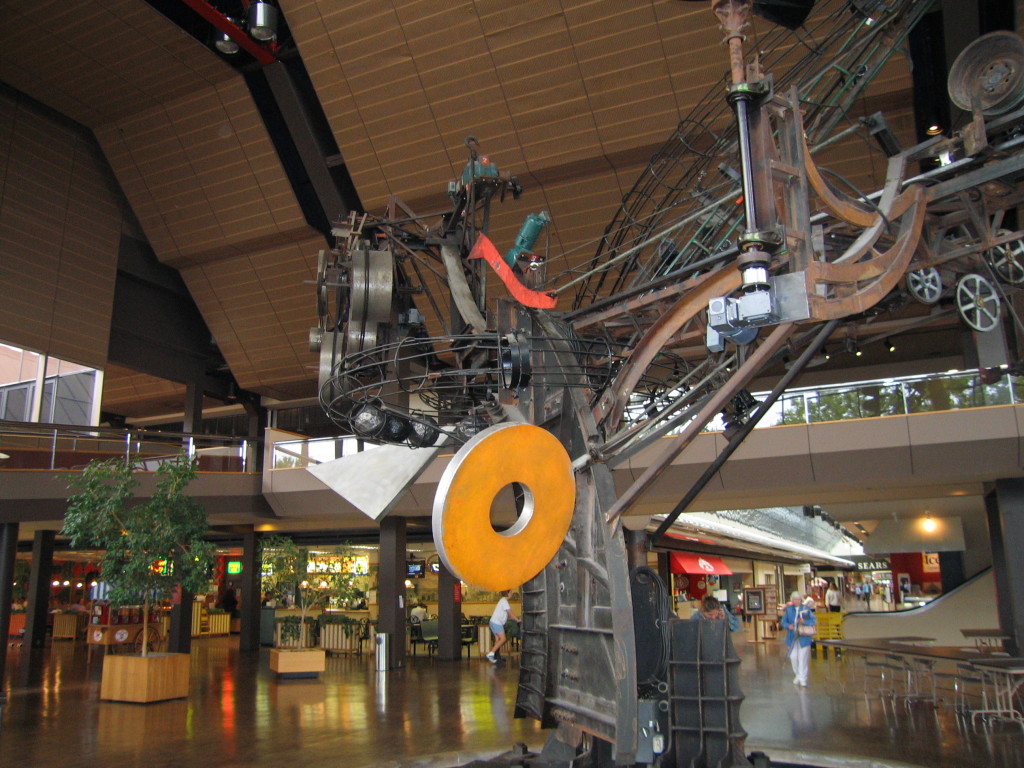
Chaos I in the original Commons
(photo by Ricky Berkey)
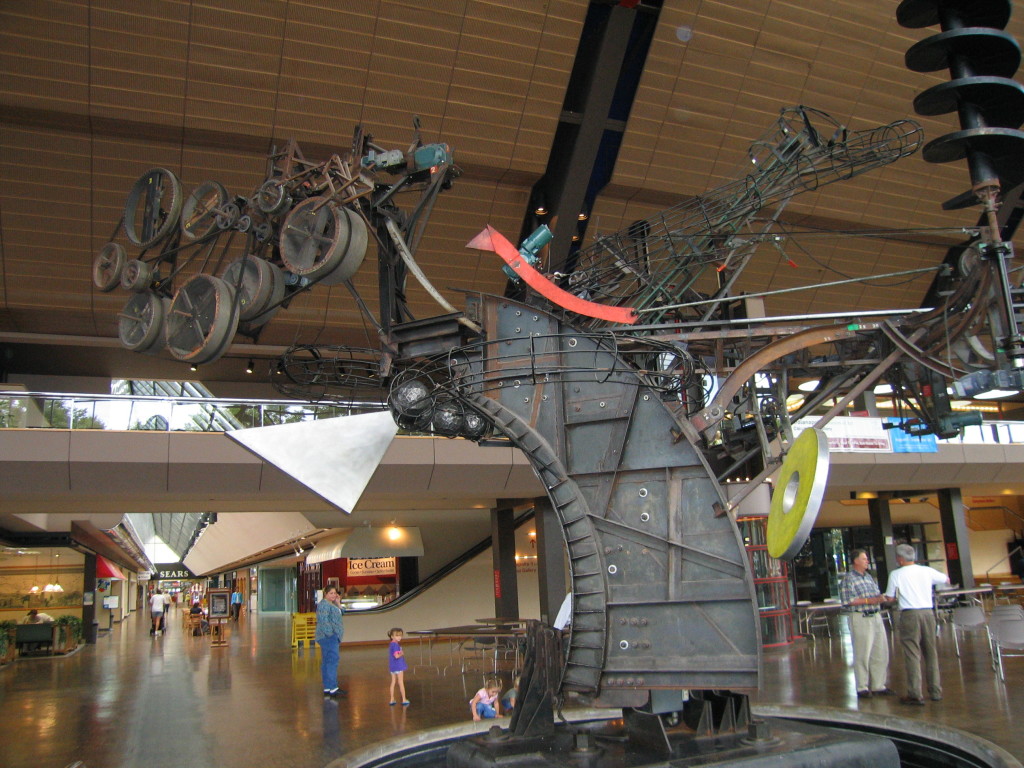
Chaos I in the original Commons
(photo by Ricky Berkey)
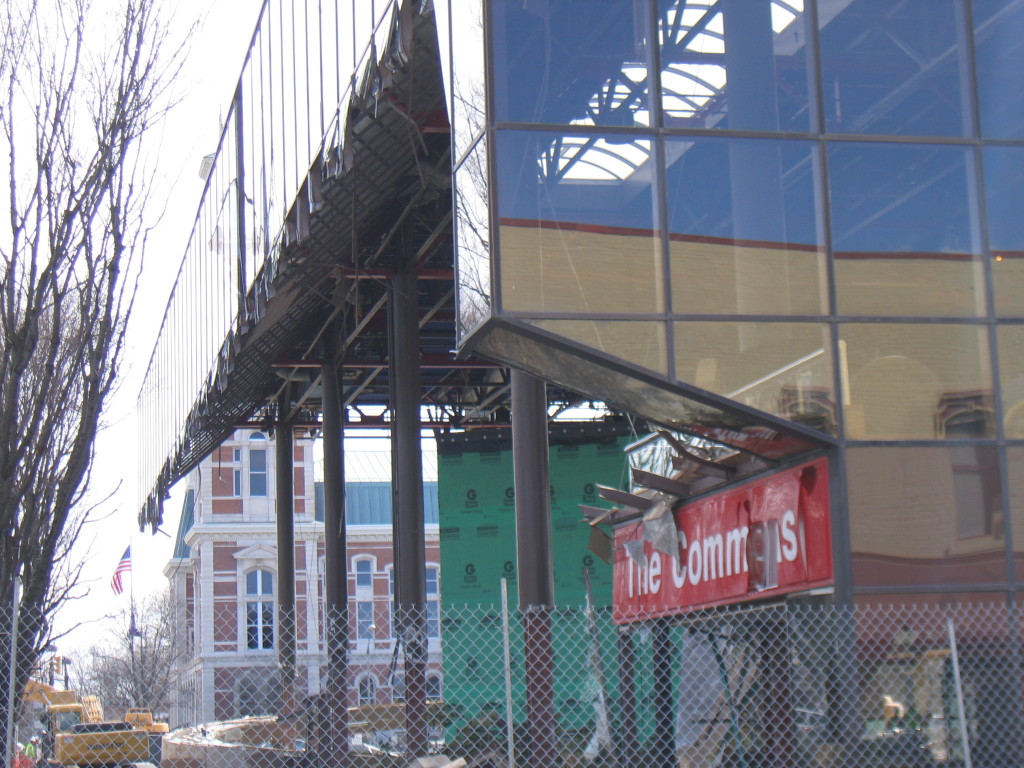
Original Commons being torn down but Chaos remains in its big green box
(photo by Ricky Berkey)

Chaos remains safe as the new building starts construction around it
(photo by Ricky Berkey)
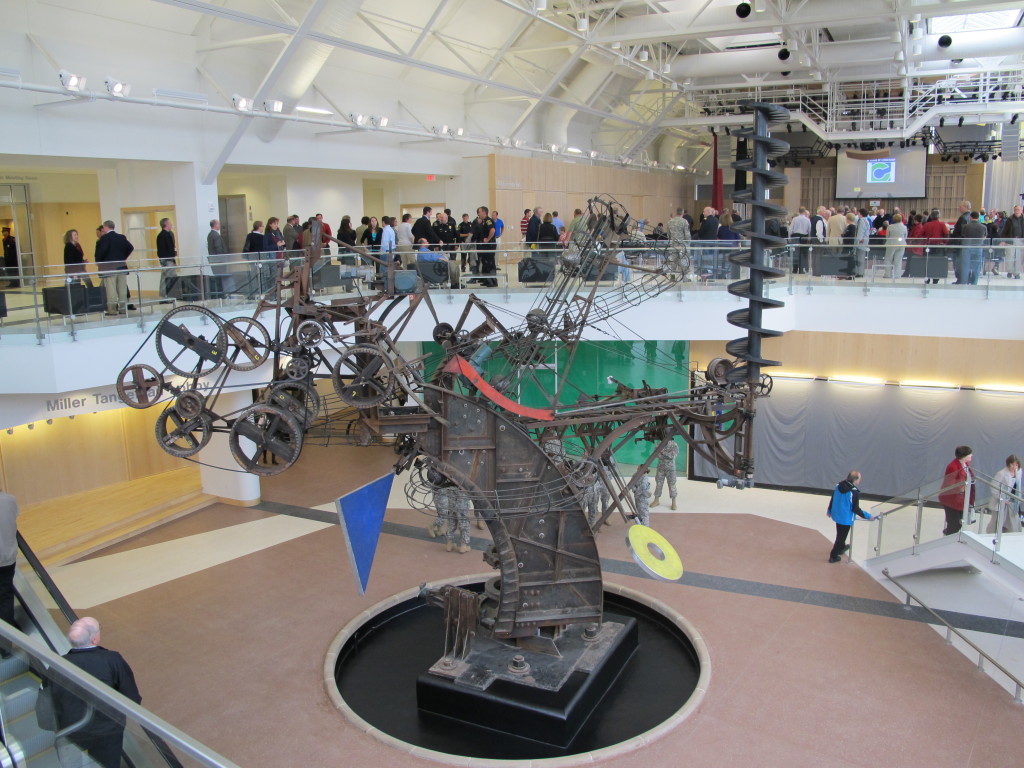
Chaos I in the “new” Commons
(photo by Ricky Berkey)

Chaos I in the “new” Commons
(photo by Ricky Berkey)
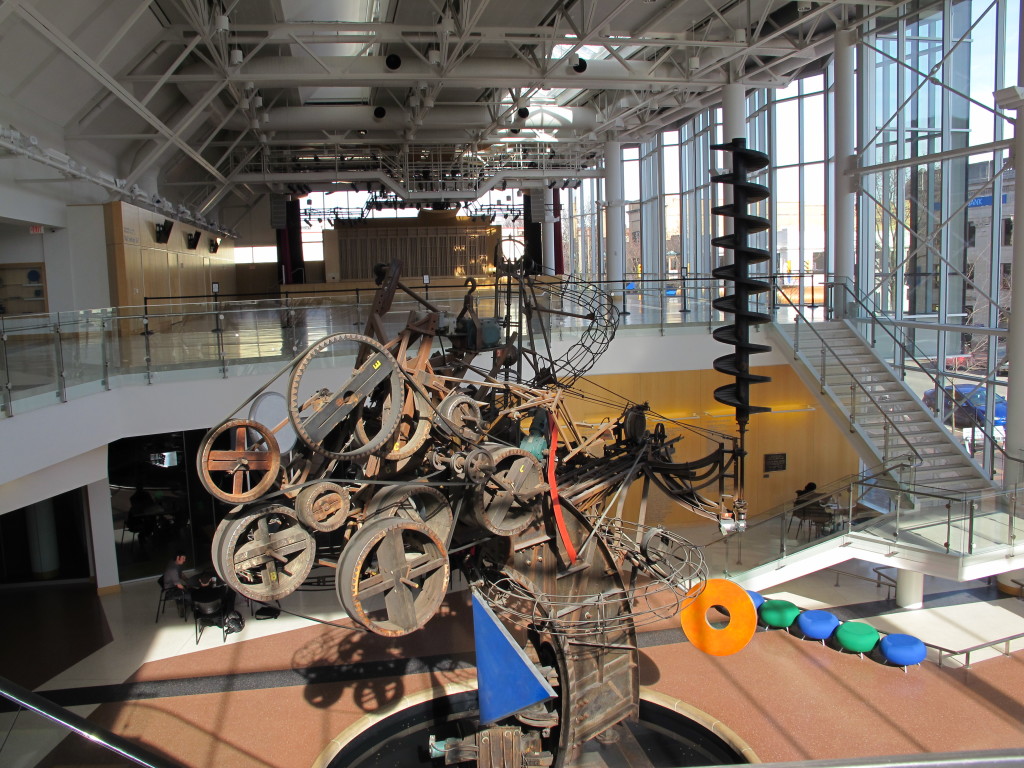
Chaos I seen from the mezzanine level
(photo by Ricky Berkey)

Wheels assembly
(photo by Ricky Berkey)
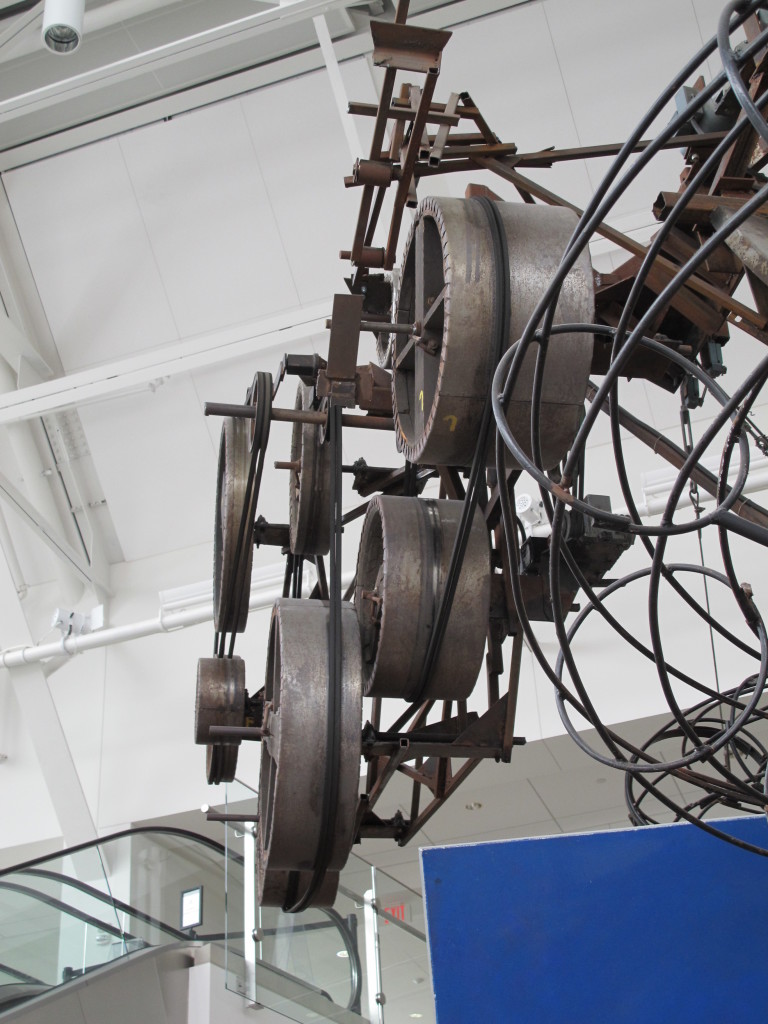
Wheels assembly
(photo by Ricky Berkey)
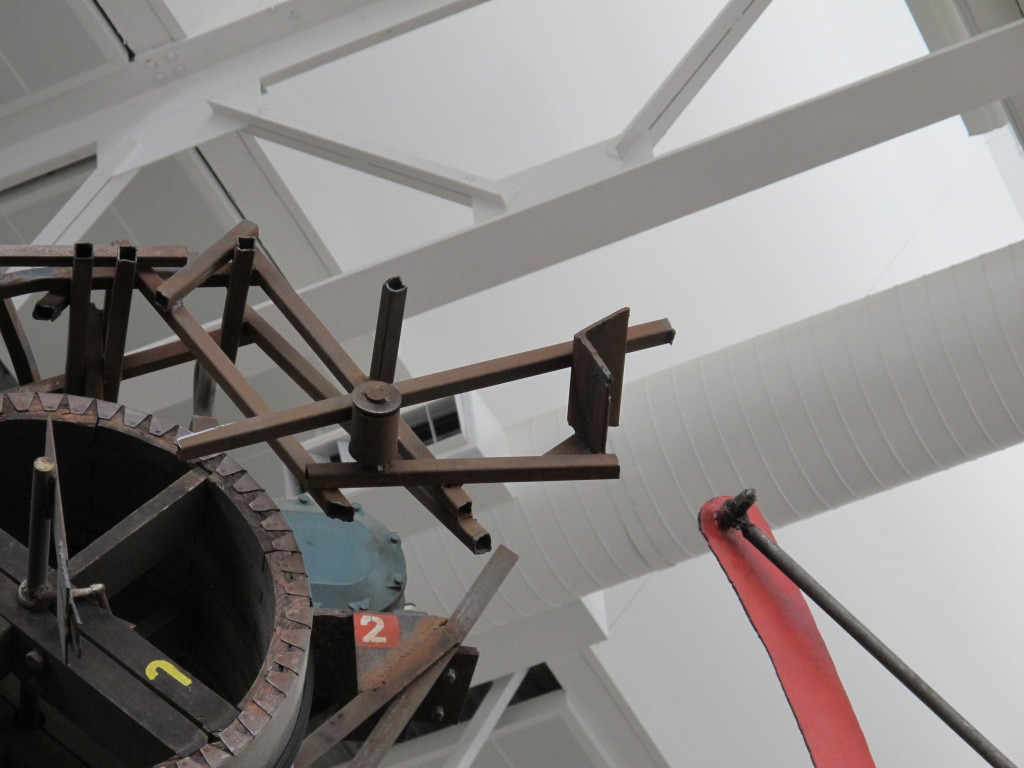
“Clangers”
(photo by Ricky Berkey)
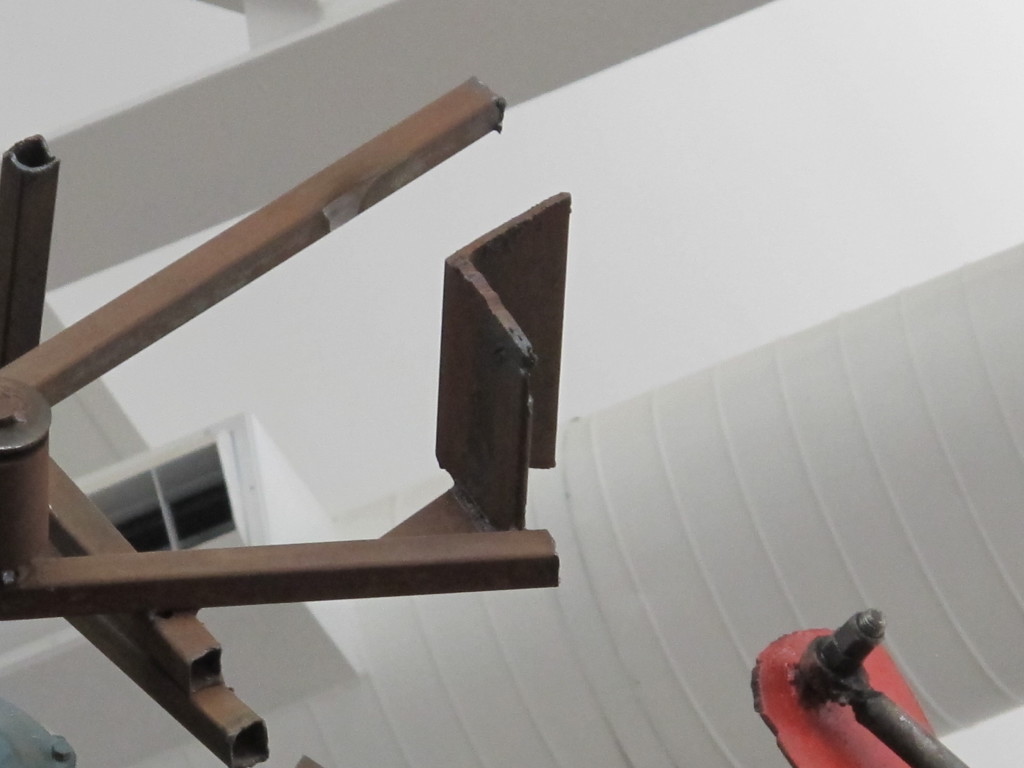
“Clangers”
(photo by Ricky Berkey)
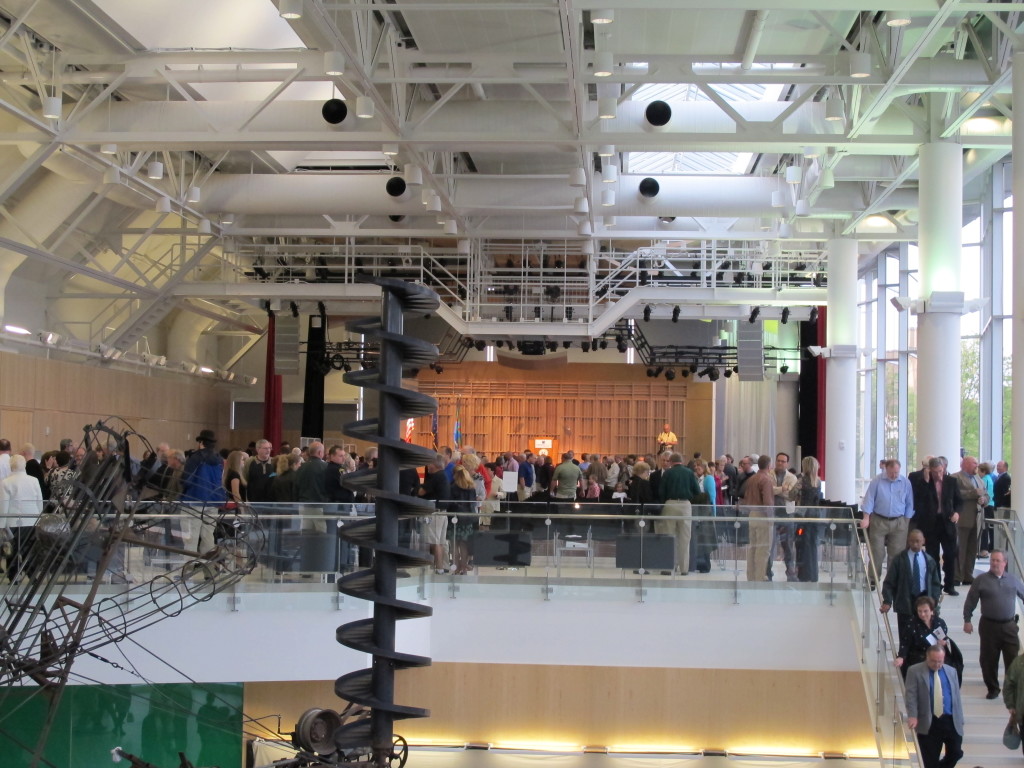
Auger rising into second level
(photo by Ricky Berkey)
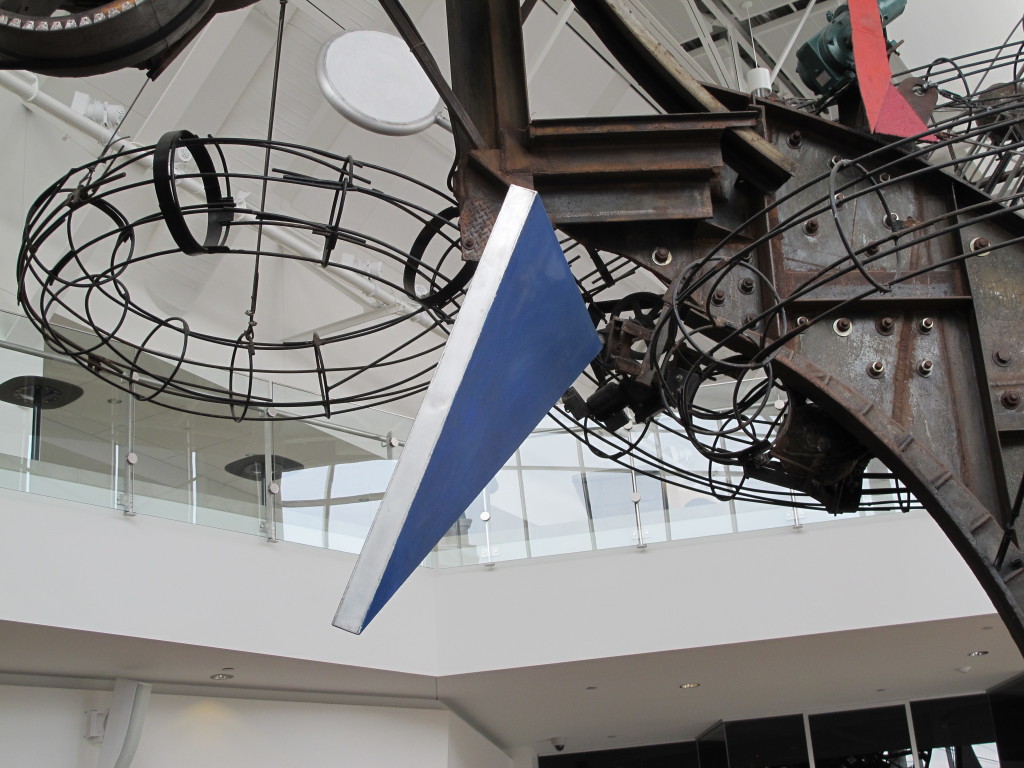
Blue triangle and ball track
(photo by Ricky Berkey)
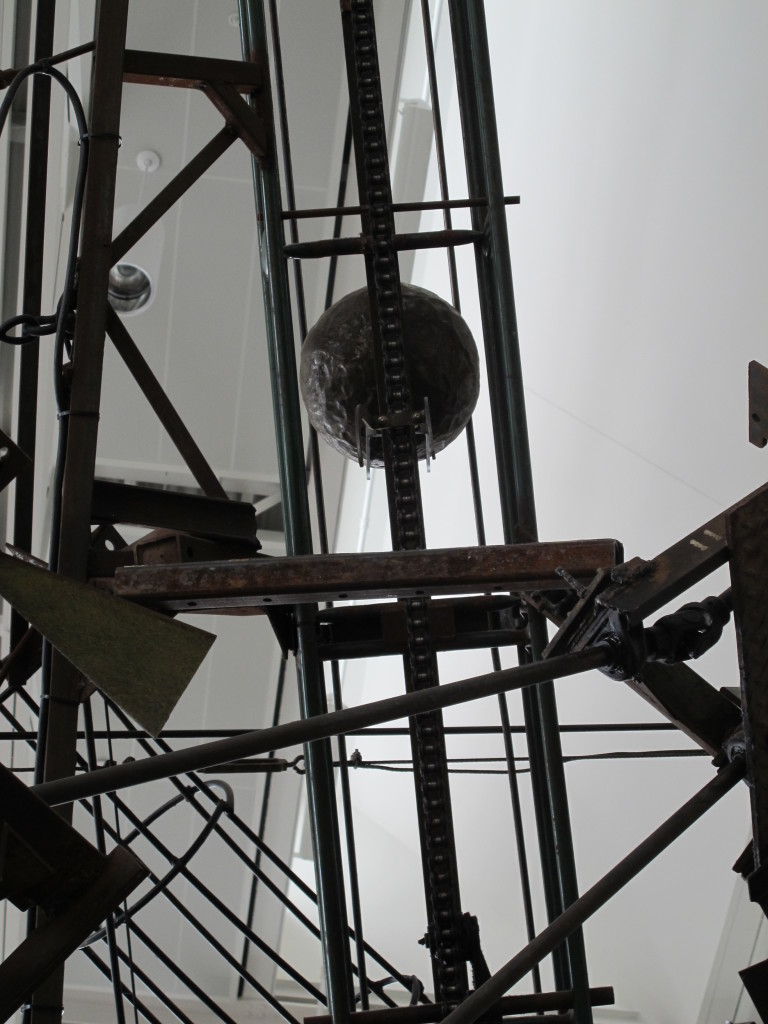
One of the balls rising to the top
(photo by Ricky Berkey)
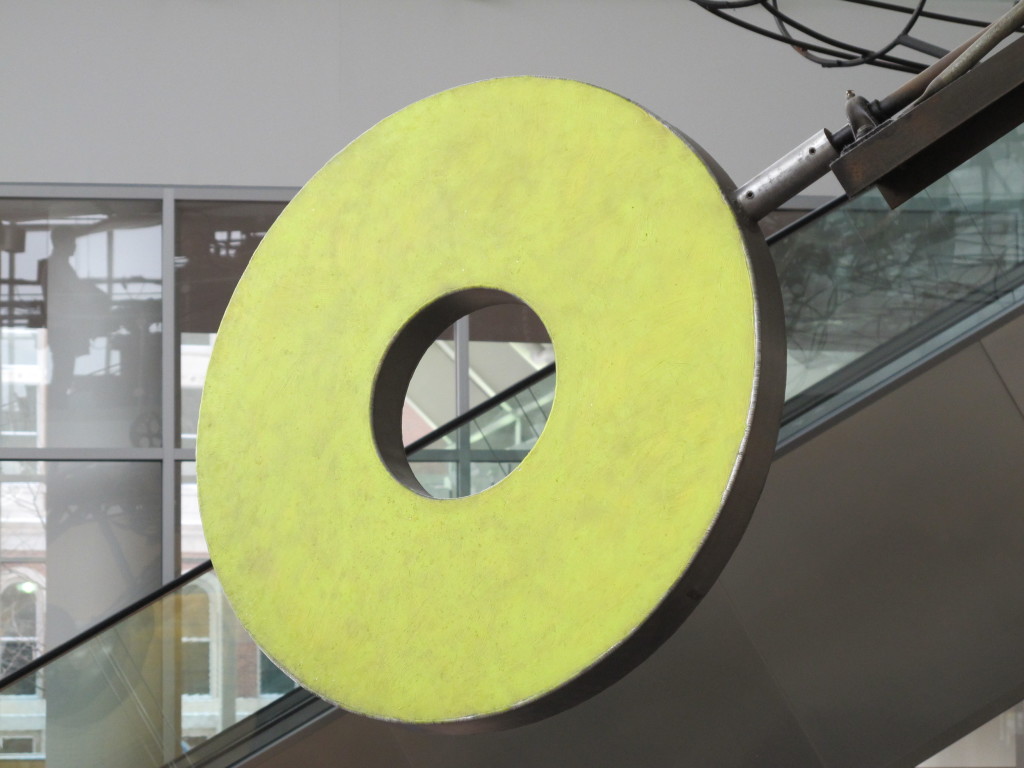
“Yellow Doughnut”
(photo by Ricky Berkey)

“Stainless Diamond”
(photo by Ricky Berkey)

Cart assembly
(photo by Ricky Berkey)

Cart assembly
(photo by Ricky Berkey)

Underside of cart assembly track
(photo by Ricky Berkey)
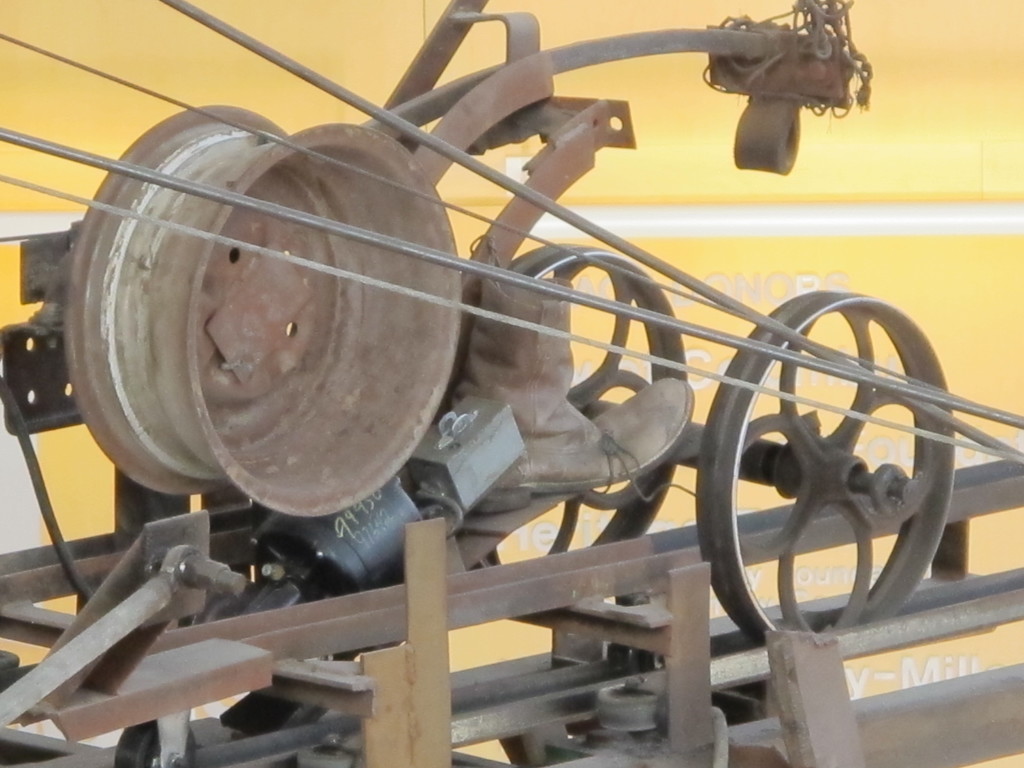
Cart assembly with the Boot
(photo by Ricky Berkey)

Nameplate on base
(photo by Ricky Berkey)
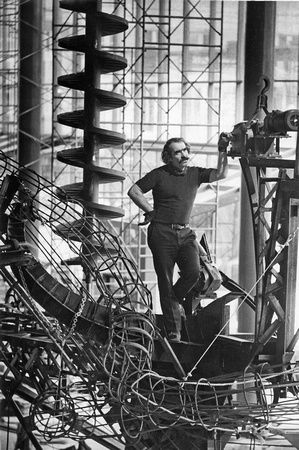 Jean Tinguely on Chaos in 1974
Jean Tinguely on Chaos in 1974
(photo used pending permission – do not copy)
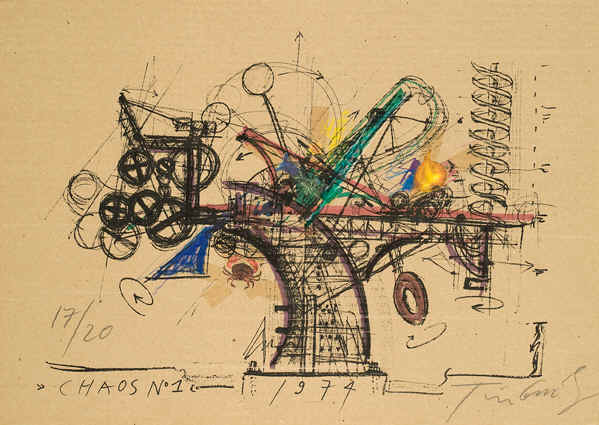 Graphic of Chaos drawn by Jean Tinguely
Graphic of Chaos drawn by Jean Tinguely
(photo used pending permission – do not copy)
The Artist
 Jean Tinguely
Jean Tinguely
- Born in Fribourg, Switzerland on May 22nd, 1925
- Died in Berne, Switzerland on August 30th, 1991
- Basel School of Fine Arts (1945)
Jean Tinguely was a Swiss sculptor and artist best known for his machine-like kinetic mechanical sculptures. His work was usually fabricated from everyday objects such as pieces of scrap or junk and was of a mechanical nature like machinery, but serving absolutely no purpose. Some of Tinguely’s works were designed to self-destruct and others were designed in such a way that predetermined a malfunction, culminating in an unpredictable finale.
Tinguely was born in Fribourg, Switzerland in 1925 as the only child of a chocolate factory worker. The family moved to Basel, Switzerland in 1928. He attended school in Basel but left in 1940 at the age of 15 to undertake an apprenticeship in window decorating for a department store. In 1941, he went to study at the School of Arts and Crafts in Basel, and was exposed to a number of artistic movements that inspired his early sculptures, such as Bauhaus, Futurism and Dadaism. Dadaism is considered to be his most prominent inspiration. He studied painting and sculpture, but early on he developed a great interest in movement as an artistic medium. He created his first kinetic art piece at the age of 12 and always felt that this was one of his best creations. It involved a series of waterwheels in a stream that interacted with other objects to make random, somewhat dissonant sounds.
Dadaism was an anarchic art movement which sought to do away with the cultural and political ideas that artists believed had been highly influenced by bourgeoisie society. Dadaist works were concerned with shaking up conventional understandings of what was considered beautiful. Artists often challenged what was aesthetically pleasing to audiences by adopting irrational techniques and nonsensical styles. Performances were designed to confuse and provoke their audiences, hoping that it would prompt them to question the aesthetic values and ‘norms’ they had inherited from society.
He moved to Paris in 1951 and began to construct his first large scale kinetic sculptures which he called “métaméchaniques” or “metamechanicals”, robot-like contraptions whose individual parts often moved or spun at varying speeds. Another type of project was his series called “machines à peindre” (“painting machines”) which continuously painted abstract patterns to the accompaniment of self-produced sounds sometimes accompanied by noxious odors!
He created the first of his infamous self-destroying structures in the early 60’s. His “Homage to New York” was a 27 foot sculpture intended to destroy itself but it had to be helped along by NYC fireman after it started a fire. He saw the concept of destruction as a means of achieving his goal of “de-materializing” art. Some saw his work posing questions about how society interacts with machines and technology challenging society’s relationship with material objects and the importance we place on them. His sculptures transcended the boundaries of ordinary performance art, replacing the man with machine. His work has been described as “cynical social commentary in a poetic way.”
In the ’70s he went on to create less aggressive and more whimsical kinetic constructions that combined aspects of the machine with those of found objects, or junk such as “Chaos I” which was the centerpiece of Cesar Pelli’s Commons building in Columbus, Indiana. He saw his work as a satire on the mindless overproduction of material goods. He also celebrated the machine and the beauty of objects discarded by our consumerist society. He once said he could see beauty in a well designed oil refinery or feel the mysticism in an electric motor. He once said “all machines are art.” He continued producing major projects and exhibitions well into the 80’s.
He was first married to Swiss artist Eva Aeppli in 1951 and later married artist Niki de Saint Phalle in 1961.
Tinguely died in 1991 in Switzerland, due to complications from a stroke at the age of 66. One of his sculptures called “Klamauk”, a drivable, tractor-like creation was actually part of his funeral procession on September 4th, 1991!
In 1996, a museum (“Museum Tinguely”) devoted to the works of Tinguely opened in Basel, Switzerland. A large variety of Tinguely’s working kinetic art sculptures are on permanent display, along with illustrations, photographs and other documents related to his life and work.
Selected Jean Tinguely Projects
1960: “Homage to New York” – a 27 foot high machine intended to destroy itself at the Museum of Modern Art in NYC.
1961: “Hon” – a climbable, walk-in female sculpture created with his wife, Niki de Saint Phalle
1962: “Study for an End of the World No. 2” – a creation detonated in front of an audience gathered in the desert outside Las Vegas, Nevada.
1964: “Heureka” (a large sculpture created for The Swiss National Exhibition (“Expo 64”) in Lausanne, Switzerland), has been located in Zurich , Switzerland since 1967.
1974: “Chaos I” – kinetic “junk” sculpture created for The Commons in Columbus, Indiana.
1979: “Klamauk” – a drivable tractor-like sculpture which actually made an appearance in his funeral procession in 1991. Now in the Tinguely Museum in Basel, Switzerland.
1981: “La Fountaine” – a fountain sculpture in Paris, France.
1991: “Cascade” – in the Carillion Building in Charlotte, North Carolina.
1991: “Le Cyclop” (The Head): Fountainbleau Forest, France. This monstrous but whimsical sculpture took nearly 30 years to complete. 300 tons of industrial debris – metal, concrete, ceramic mosaic, stones – mirrors and a waterfall! He was periodically returning to France to work on this while working on Chaos in Columbus, Indiana.
Links/References
“Talking Chaos” – Richard McCoy interviews Roland Wetzel of the Tinguely Museum in Basel, Switzerland
“Chaos No. 1” – Richard Denney film rediscovered by Chris Crawl
“Controlling Chaos” – Comical short film inside the old Commons with William Robert (film by Brian Presnell)
City of Columbus: official City of Columbus website
Columbus Indiana Architectural Archives
Columbus Indiana Architecture Digital Archives: A small portion of the Columbus Indiana Architectural Archives available online from the IUPUI digital library
3D Models of Columbus Architecture Executed in Google SketchUp:
The Republic Newspaper – Columbus, Indiana newspaper
Bartholomew County Public Library
Historic Columbus Website – David Sechrest’s tribute to Columbus History
Historic Columbus Message Board – a companion interactive forum to the David Sechrest historical website
Bartholomew County Historical Society
 Click HERE for a Calendar of Upcoming Events in the Columbus Area.
Click HERE for a Calendar of Upcoming Events in the Columbus Area.
Click HERE for information about Tours of Columbus Architecture and Design including the Miller House.
 Ricky Berkey
Ricky Berkey
Email me: rickyberkey@gmail.com

